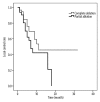Thermal ablation of unresectable liver tumors: factors associated with partial ablation and the impact on long-term survival
- PMID: 22293882
- PMCID: PMC3560593
- DOI: 10.12659/msm.882463
Thermal ablation of unresectable liver tumors: factors associated with partial ablation and the impact on long-term survival
Abstract
Background: Thermal ablation procedures, including radiofrequency ablation (RFA) or laser-induced interstitial thermotherapy (LITT), are now well established in the treatment of malignant unresectable hepatic tumors. But the impact of partial ablation (PA) on long-term survival following computed tomography (CT)-guided radiofrequency ablation and laser- induced interstitial thermotherapy of unresectable malignant liver lesions and the associated risk factors of PA remain partially unknown.
Material/methods: This study included 254 liver tumors in 91 consecutive patients (66 men and 25 women; age 60.9 ± 10.4 years; mean tumor size 25 ± 14 mm [range 5-70 mm]) who underwent thermal ablation (RFA or LITT) between January 2000 and December 2007. Mean follow-up period was 21.1 month (range 1-69 months). Survival rate and local progression-free survival (PFS) were calculated for patients with complete ablation (CA) vs. patients with partial ablation (PA) to assess the impact on long-term survival.
Results: Median survival after CA was 47 months compared to 25 months after PA (P=0.04). The corresponding 5-year survival rates were 44% vs. 20%. Median PFS for CA was 11 months compared to 7 months for PA (P=0.118). The sole statistically significant risk factor for PA was tumor size (>30 mm; P=0.0003). Sustained complete ablation was achieved in 71% of lesions ≤ 30 mm vs. 47% of lesions >30 mm.
Conclusions: We conclude that achievement of complete ablation is a highly important predictor of long-term survival and that tumor size is by far the most important predictor of the likelihood of achieving complete ablation.
Figures
Similar articles
-
Thermal Ablation of Colorectal Lung Metastases: Retrospective Comparison Among Laser-Induced Thermotherapy, Radiofrequency Ablation, and Microwave Ablation.AJR Am J Roentgenol. 2016 Dec;207(6):1340-1349. doi: 10.2214/AJR.15.14401. Epub 2016 Sep 28. AJR Am J Roentgenol. 2016. PMID: 27680945
-
Long-term survival of patients with unresectable colorectal liver metastases treated by percutaneous interstitial laser thermotherapy.World J Surg. 2004 Oct;28(10):987-94. doi: 10.1007/s00268-004-7202-1. Epub 2004 Sep 29. World J Surg. 2004. PMID: 15573253
-
Ablation therapy of non-colorectal cancer lung metastases: retrospective analysis of tumour response post-laser-induced interstitial thermotherapy (LITT), radiofrequency ablation (RFA) and microwave ablation (MWA).Int J Hyperthermia. 2017 Nov;33(7):820-829. doi: 10.1080/02656736.2017.1306656. Epub 2017 Apr 3. Int J Hyperthermia. 2017. PMID: 28540791
-
Thermal ablation of liver metastases from colorectal cancer: radiofrequency, microwave and laser ablation therapies.Radiol Med. 2014 Jul;119(7):451-61. doi: 10.1007/s11547-014-0415-y. Epub 2014 Jun 4. Radiol Med. 2014. PMID: 24894923 Review.
-
Other thermal ablation techniques: microwave and interstitial laser ablation of liver tumors.Ann Surg Oncol. 2003 Jun;10(5):491-7. doi: 10.1245/aso.2003.07.016. Ann Surg Oncol. 2003. PMID: 12794014 Review.
Cited by
-
Ablative and non-surgical therapies for early and very early hepatocellular carcinoma: a systematic review and network meta-analysis.Health Technol Assess. 2023 Dec;27(29):1-172. doi: 10.3310/GK5221. Health Technol Assess. 2023. PMID: 38149643 Free PMC article.
-
Thermal ablation with configurable shapes: a comprehensive, automated model for bespoke tumor treatment.Eur Radiol Exp. 2023 Nov 7;7(1):67. doi: 10.1186/s41747-023-00381-6. Eur Radiol Exp. 2023. PMID: 37932631 Free PMC article.
-
Laser-induced interstitial thermotherapy via a single-needle delivery system: Optimal conditions of ablation, pathological and ultrasonic changes.J Huazhong Univ Sci Technolog Med Sci. 2015 Aug;35(4):579-584. doi: 10.1007/s11596-015-1474-6. Epub 2015 Jul 31. J Huazhong Univ Sci Technolog Med Sci. 2015. PMID: 26223931
-
High temperature hyperthermia treatment for canines exhibiting superficial tumors: A report of three cases.Oncol Lett. 2014 Nov;8(5):2055-2058. doi: 10.3892/ol.2014.2496. Epub 2014 Sep 3. Oncol Lett. 2014. PMID: 25295089 Free PMC article.
References
-
- Curley SA, Izzo F. Radiofrequency ablation of primary and metastatic hepatic malignancies. Int J Clin Oncol. 2002;7(2):72–81. - PubMed
-
- Dupuy DE, Goldberg SN. Image-guided radiofrequency tumor ablation: challenges and opportunities – part II. J Vasc Interv Radiol. 2001;12(10):1135–48. - PubMed
-
- Gazelle GS, Goldberg SN, Solbiati L, Livraghi T. Tumor ablation with radio-frequency energy. Radiology. 2000;217(3):633–46. - PubMed
-
- Tateishi R, Shiina S, Teratani T, et al. Percutaneous radiofrequency ablation for hepatocellular carcinoma. An analysis of 1000 cases. Cancer. 2005;103(6):1201–9. - PubMed
-
- Vogl TJ, Straub R, Eichler K, et al. Colorectal carcinoma metastases in liver: laser-induced interstitial thermotherapy – local tumor control rate and survival data. Radiology. 2004;230(2):450–58. - PubMed
Publication types
MeSH terms
LinkOut - more resources
Full Text Sources
Medical



